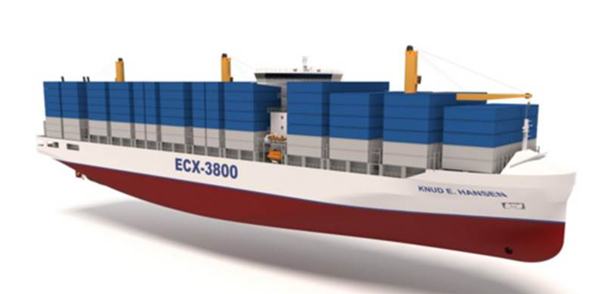
Pioneering designs for container feeder vessels

The ECX-3800 TEU feeder vessel
The first of three designs is for a 2,000-TEU vessel meant to specialise in calling at small, narrow, upriver ports, for example the port of Bangkok, Thailand. Navigating harbours of this kind requires a vessel to have a shallow draught – in the case of Bangkok, not more than 8.2m.
A second design is for a vessel that doesn't need such a shallow draught and has a 3,800-TEU capacity. With draught not being a primary consideration, this design sees the feeder vessel fitted out with a larger-diameter, slower-turning propeller.
Unlike most feeder vessels, this one has a deckhouse positioned slightly forward of amidships to maximise the number of container slots on deck considering IMO line-of-sight requirements from the bridge. The extra number of slots can be utilised in real loading conditions because the vessel is wider and has greater stability than most feeder vessels of this size.
The third arrangement sees the application of an innovative hull shape suited for carriage of both partial and full container loads. The problem arises out of the differing ways in which a vessel behaves based on its load. A large container vessel, when carrying few containers, has shallow draught but so much stability that accelerations are too high, causing problems for the lashing gear and the crew.
The solution proposed by Knud E. Hansen is that instead of a conventional hull, a hull with inclined sides is taken but the triangular sections in each side are mirrored to create a trimaran or, more precisely, a “stabilised mono-hull” with a narrow main hull having vertical sides and outrigger hulls with a triangular cross section but vertical sides towards the quay. This way the narrowness associated with low accelerations at partial load is achieved and, with the triangular section of the outrigger hulls, the vessel has increased stability for full loads at deeper draught.
The design features an open-top section in the main hull, with 40' containers stacked in a fixed cell guide system. Because cell guides are not fitted outboard the main hull above the outriggers, the loading flexibility with regard to carrying 20', 45' and 48' containers has been addressed.
